Wikipedia:Picture of the day/April 2020
|
Featured picture tools: |
These featured pictures, as scheduled below, appeared as the picture of the day (POTD) on the English Wikipedia's Main Page in April 2020. Individual sections for each day on this page can be linked to with the day number as the anchor name (e.g. [[Wikipedia:Picture of the day/April 2020#1]] for April 1).
You can add an automatically updating POTD template to your user page using {{Pic of the day}} (version with blurb) or {{POTD}} (version without blurb). For instructions on how to make custom POTD layouts, see Wikipedia:Picture of the day.Purge server cache
April 1
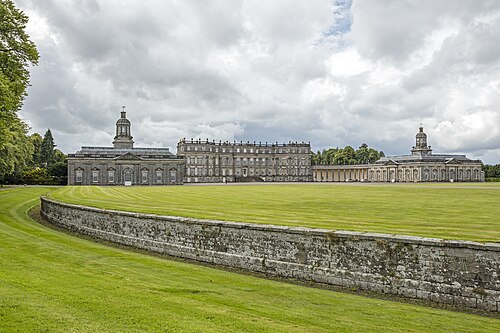
|
|
A ha-ha is a recessed landscape design element that creates a vertical barrier while preserving an uninterrupted view of the landscape beyond. The design includes a turfed incline that slopes downward to a sharply vertical face, typically a masonry retaining wall. Ha-has are used in landscape design to prevent access to a garden, for example by grazing livestock, without obstructing views. In security design, the element is used to deter vehicular access to a site while minimizing visual obstruction. The name "ha-ha" is thought to have stemmed from the exclamations of surprise by those coming across them, as the walls were intentionally designed so as not to be visible on the plane of the landscape. This picture shows a ha-ha at Hopetoun House in West Lothian, Scotland, which keeps animals off the lawn while remaining unseen from the main house, visible here in the background. The wall disappears from view as it curves away to the left of the photograph. Photograph credit: Andrew Shiva
Recently featured:
|
April 2
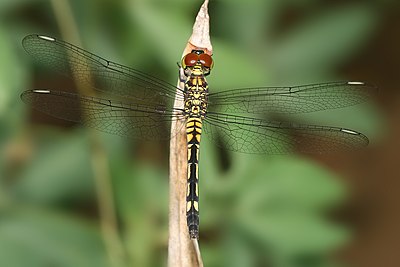
|
Chalcostephia flavifrons is a species of dragonfly native to tropical central Africa. A small species, the wings are about 1 in (2.5 cm) in length and are translucent apart from the pterostigmata. The purpose of these thicker, pigmented sections near the wingtip is to prevent wing flutter, and thus assist in gliding. The wing venation is characteristic of the species. This dragonfly is commonly known as the "yellowface", but seen from above, the head is largely obscured by the enormous compound eyes which almost meet in the middle, giving the insect a wide field of view and enabling it to see in all directions. This picture shows a female C. flavifrons dragonfly photographed in Dar es Salaam, Tanzania. Photograph credit: Muhammad Mahdi Karim
Recently featured:
|
April 3

|
Jane Digby (3 April 1807 – 11 August 1881) was an English aristocrat, famed for her remarkable love life and lifestyle. She had four husbands and many lovers, including King Ludwig I of Bavaria, his son King Otto of Greece, Bohemian nobleman and Austrian statesman Prince Felix of Schwarzenberg, and Greek general Christodoulos Hatzipetros. She died in Damascus, Syria, as the wife of Arab sheikh Medjuel el Mezrab, who was twenty years her junior. This picture is an undated portrait miniature of Digby by William Charles Ross. She is seated in front of hanging drapery, wearing a green dress with amber and green shoulder rolls, with a jewelled sash, sapphire and emerald pendant necklace, and neckline edged with white lace. Her blonde hair is partially curled and upswept, and dressed with strands of pearls. Painting credit: William Charles Ross
Recently featured:
|
April 4
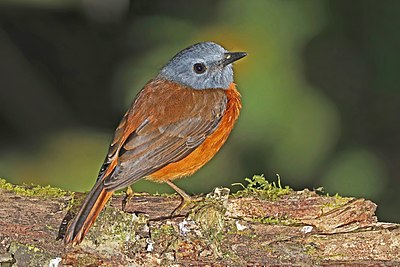
|
The Amber Mountain rock thrush (Monticola sharpei erythronotus) is a songbird in the Old World flycatcher family Muscicapidae, endemic to Amber Mountain, an isolated volcanic massif at the northern tip of the island of Madagascar. It inhabits woodland, where it forages for insects and other small prey. The taxon is generally considered to be a subspecies of the forest rock thrush, but has also been regarded as a separate species. It is listed by the International Union for Conservation of Nature as endangered because of its very limited range and the destruction of its forest habitat. This picture shows a male Amber Mountain rock thrush photographed in Montagne d'Ambre National Park. The female is a much less conspicuous bird, with largely brown plumage. Photograph credit: Charles J. Sharp
Recently featured:
|
April 5

|
Bianca Maria Sforza (5 April 1472 – 31 December 1510) was the third wife of Maximilian I, Holy Roman Emperor. She was married when 21 months old to her first cousin Philibert I, Duke of Savoy, and became a widow at the age of ten, when he died of tuberculosis. After her father Galeazzo Maria Sforza, Duke of Milan, was assassinated when she was a child, her education was neglected. Her marriage to Maximilian in 1494 was unhappy; she became pregnant several times but failed to produce a living child, and he compared her unfavourably to his first wife, describing her as uneducated, talkative, naive, wasteful with money, and careless. This picture is an oil-on-poplar portrait of Bianca by Italian Renaissance artist Giovanni Ambrogio de Predis, probably painted in 1493. The work is in the collection of the National Gallery of Art in Washington, D.C. Painting credit: Giovanni Ambrogio de Predis
Recently featured:
|
April 6

|
Charles Marion Russell (1864–1926) was an artist of the Old American West who created more than two thousand paintings of cowboys, Indians, and landscapes set in the western United States and in Alberta, Canada. He became an advocate for Native Americans in the West, for instance supporting the bid by landless Chippewa to have a reservation established for them in Montana. This picture is a 1908 oil-on-canvas painting by Russell, entitled Smoke of a .45, depicting an action-packed scene in a dry, dusty landscape. The work is now in the collection of the Amon Carter Museum of American Art in Fort Worth, Texas. Painting credit: Charles Marion Russell
Recently featured:
|
April 7

|
Saint Gregory the Illuminator Cathedral is the largest Armenian Apostolic Church cathedral in the world. Located in the Armenian capital Yerevan, construction started in 1997 and the consecration took place on 23 September 2001, on the occasion of the 1,700th anniversary of the proclamation of Christianity as the state religion of Armenia. The building consists of three churches, the nave, with seating for 1,700, and the side chapels of Saint Tiridates the King and Saint Ashkhen the Queen, each of which has 150 seats; these two royal figures provided crucial help to Saint Gregory the Illuminator in his task of converting Armenia to Christianity. The belfry tower is located above the entrance, and rooms for receptions and church-related activities are provided on the lower floor. Photograph credit: Marcin Konsek
Recently featured:
|
April 8

|
Mary Pickford (April 8, 1892 – May 29, 1979) was a Canadian-born American film actress and producer. With a career spanning 50 years, starting in the silent era, she was a co-founder of both the Pickford–Fairbanks Studio (along with Douglas Fairbanks, whom she subsequently married) and later, the United Artists film studio (with Fairbanks, Charlie Chaplin and D. W. Griffith). She was one of the original thirty-six founders of the Academy of Motion Picture Arts and Sciences, which presents the yearly Academy Awards. This photograph of Pickford was taken around 1910, when she was becoming one of the most popular actresses of the period, earning the nickname "Queen of the Movies". Being of short stature, she often played the roles of children, but later found her career fading as talkies became more popular among audiences and she was cast in more adult roles. She retired from acting in 1933, becoming involved in production and other aspects of the film industry. Photograph credit: Rufus Porter Moody |
April 9

|
Thysanozoon nigropapillosum, the yellow-spotted flatworm, is a species of marine flatworm in the family Pseudocerotidae. The species is native to the tropical Indo-Pacific region, where it lives in shallow reef habitats. Flatworms are hermaphrodites, each being able to act as either male or female. As a donor of sperm, it can grip the margin of the recipient's body, using its two penises in a chopstick-like manner, and deposit sperm on the surface of the skin of the recipient, even while it is actively swimming. This picture shows a yellow-spotted flatworm photographed in Manta Ray Bay, on the island of Yap in the Federated States of Micronesia. The flatworm is seen swimming to the right at a depth of 12 metres (40 ft) by undulating the margins of its body. The pseudotentacles at the front have simple eyes and sensory receptors to enable the flatworm to find tunicates on which it feeds. Photograph credit: Betty Wills
Recently featured:
|
April 10

|
Christ Crucified is a 1780 oil-on-canvas painting of the crucifixion of Jesus. The Spanish Romantic artist Francisco Goya presented it to the Real Academia de Bellas Artes de San Fernando as his reception piece to meet the requirements for admission. The painting is neoclassical in style and is similar to the treatment of the same topic by Velázquez and Anton Raphael Mengs. Goya conforms to the Spanish Baroque iconographic rules for portraying the Crucifixion as laid down by Francisco Pacheco – a black background, four rather than three nails, supported feet, and a trilingual inscription in Hebrew, Greek and Latin affixed to the top of the cross reading 'King of the Jews'. The work now forms part of the permanent collection of the Museo del Prado in Madrid. Painting credit: Francisco Goya |
April 11

|
|
The polar bear (Ursus maritimus) is a hypercarnivorous bear whose native range lies largely within the Arctic Circle. It hunts its preferred food of seals, which make up most of its diet, from the edge of sea ice. This picture shows a malnourished polar bear on an ice floe in the Hinlopen Strait in Svalbard, Norway. The main danger posed to bears by global warming is malnutrition or starvation due to habitat loss. In summer, some polar bears, such as this one, do not make the transition from their winter residence on the islands of Svalbard to the dense drift ice and pack ice of the high Arctic, where they would find a plethora of prey; this is caused by climate change resulting in the ice around the islands melting much earlier than in previous years. This forces the bears to change to a diet of detritus, small animals, bird eggs, and the carcasses of marine animals. Very often, they suffer starvation and are doomed to die. Besides this, insufficient nourishment leads to lower reproductive rates among adult females and the juveniles and cubs have lower survival rates. Photograph credit: Andreas Weith
Recently featured:
|
April 12

|
Charles Foster (April 12, 1828 – January 9, 1904) was a Republican politician from the U.S. state of Ohio. He was a member of the U.S. House of Representatives from 1871 to 1879, and later served as the 35th governor of Ohio from 1880 to 1884. In 1891, he was appointed Secretary of the Treasury by President Benjamin Harrison, serving until 1893 before retiring. This picture is a line engraving of Foster, produced around 1902 by the Department of the Treasury's Bureau of Engraving and Printing (BEP), as part of a BEP presentation album of the first 42 secretaries of the treasury, which was reportedly given to Secretary Lyman J. Gage. Engraving credit: Bureau of Engraving and Printing; restored by Andrew Shiva
Recently featured:
|
April 13
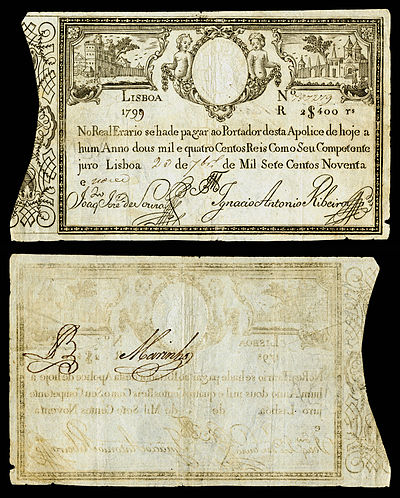
|
The Portuguese real was the unit of currency of Portugal from around 1430 to 1911. It replaced the dinheiro at the rate of 1 real for 840 dinheiros, and was itself replaced by the escudo as a result of the Republican revolution of 1910 at a rate of 1 escudo for 1,000 réis. This picture shows a 2,400-real banknote issued as part of Portugal's second issue of paper money in 1798–99. The Portuguese text on the note's obverse (top) translates to: 'The Royal Treasury has to pay the bearer of this policy within one year of today two thousand and four hundred réis. As its representative I swear, Lisbon, 23 April 1799.' It was thus a receipt payable to the bearer of the document, rather than the original depositor. The curved cut in the scrollwork in the left margin was an early anti-counterfeiting measure; the severed portion was retained by the issuing authority and could be compared to the note when it was presented for payment. This banknote is now in the National Numismatic Collection at the Smithsonian Institution's National Museum of American History. Banknote design credit: Imperial Treasury, Kingdom of Portugal; photographed by Andrew Shiva
Recently featured:
|
April 14

|
The assassination of Abraham Lincoln on April 14, 1865, was part of a larger conspiracy by John Wilkes Booth intended to revive the Confederate cause by eliminating the three most important officials of the United States government. Booth was a well known stage actor, and shot President Lincoln once in the back of the head while the president was watching the play Our American Cousin at Ford's Theatre in Washington, D.C. Also present in the box, as guests of the president and First Lady Mary Todd Lincoln, were Major Henry Rathbone and his fiancée Clara Harris. This picture is a 4-by-3-inch (102 mm × 76 mm) glass-slide illustration of Lincoln's assassination, designed for projection in a magic lantern and dating from around 1900. From left to right, the figures depicted are Booth, President Lincoln, Mary Lincoln, Harris and Rathbone. Illustration credit: unknown, after T. M. McAllister; restored by Adam Cuerden
Recently featured:
|
April 15

|
Paisley Abbey is a parish church of the Church of Scotland, located in the centre of the town of Paisley, Renfrewshire, about 12 miles (19 km) west of Glasgow. Saint Mirin founded a community here in the 7th century, and a priory was established in 1163. A succession of fires and the collapse of the tower during the 15th and 16th centuries left the building in a partially ruined state. From 1858 to 1928, the north porch and the eastern choir were reconstructed on the remains of the ruined walls. This photograph shows the interior of Paisley Abbey, looking eastwards from the transept towards the choir, with the high altar and the great east window visible in the background and the organ on the right. Photograph credit: Colin
Recently featured:
|
April 16

|
Élisabeth Vigée Le Brun (16 April 1755 – 30 March 1842) was a prominent French portrait painter. Her artistic style is generally considered part of the aftermath of Rococo, with elements of an adopted Neoclassical style. She enjoyed the patronage of European aristocrats, actors, and writers, most notably serving as Marie Antoinette's portrait painter, and created some 660 portraits and 200 landscapes, which are now owned by major museums and collections in Europe and the United States. This oil-on-canvas painting, entitled Self-Portrait in a Straw Hat, was painted by Vigée Le Brun sometime after 1782. She is depicted in the open air against a cloud-dotted sky, wearing a straw hat decorated with an ostrich feather and a posy of rustic flowers. The artwork was a "free imitation" of Portrait of Susanna Lunden by Rubens, in particular the blend of two forms of illumination: natural daylight and the radiance of the sun. Unlike the sitter of Rubens's portrait, who crosses her arms and peers out from below her hat, Vigée Le Brun portrays herself as being friendly and welcoming to the viewer. Painting credit: Élisabeth Vigée Le Brun
Recently featured:
|
April 17

|
Pterophorus pentadactyla, commonly known as the white plume moth, is a European moth in the family Pterophoridae. The adult has a wingspan of about 30 mm (1.2 in); it is pure white, the wings being divided into five slender feather-like plumes, two forming part of the forewing and three the hindwing. The larvae are green, with a yellow dorsal stripe and tufts of pale hairs, and feed on plants in the family Convolvulaceae. This is a dorsal view of a male P. pentadactyla found at Sainte-Croix-Volvestre, France, and preserved in the Muséum de Toulouse. Photograph credit: Didier Descouens
Recently featured:
|
April 18

|
Marvel Science Stories was an American pulp magazine edited by Robert O. Erisman, which ran for a total of fifteen issues in two separate runs, the first between August 1938 and April 1941, and the second in the 1950s, when there was a boom in science-fiction magazines. This picture is an illustration by Alex Schomburg from an interior page of the April–May 1939 issue of Marvel Science Stories, accompanying Harl Vincent's story "Newscast". Schomburg was a Puerto Rican commercial artist and comic-book illustrator whose career in the United States lasted over seventy years, creating many covers for comics in the 1940s, including those featuring Captain America, Namor, the Human Torch, and other superheroes. He later moved on to covers and illustrations for science-fiction magazines, astrology publications, and books, including the juvenile series Winston Science Fiction. Vincent, an engineer by profession, earned a second income by publishing more than seventy science fiction stories in magazines, mostly in the 1930s and early 1940s, but a few in the 1960s, late in his life. Illustration credit: Alex Schomburg; restored by Adam Cuerden
Recently featured:
|
April 19

|
Hendrik Voogd (1768–1839) was a Dutch painter and printmaker who spent his active life in Italy. He was known as the "Dutch Claude", because some of his landscape paintings resembled those of the French painter Claude Lorrain, whose landscapes were often bathed in golden light. This picture is an 1807 oil-on-canvas painting by Voogd, entitled Italian Landscape with Umbrella Pines, depicting the gardens of the Villa Borghese in Rome in the late afternoon. People can be seen strolling amongst the trees, which stand out sharply against the sky and cast long shadows across the lawns. In the foreground, an artist is shown at work beside a fallen tree. The painting is now in the collection of the Rijksmuseum in Amsterdam. Painting credit: Hendrik Voogd
Recently featured:
|
April 20

|
Duke Humfrey's Library is the oldest reading room in the Bodleian Library at the University of Oxford. It is named after Humphrey, Duke of Gloucester, a connoisseur of literature, who donated his collection of 281 books to the university at his death in 1447. Books were hand-written at the time and his legacy was considered an extraordinarily generous donation, since the university previously had only 20 books. Only three books from the original donation remain, the rest having been removed in 1550 and probably burnt during the Reformation. The library was restored and restocked by Thomas Bodley from 1598 onwards. The books in the oldest part of the library are accommodated in oak bookcases that are at right angles to the walls on either side, with integrated reading desks. The ceiling consists of panels painted with the coat of arms of the University of Oxford. This picture shows the interior of Duke Humfrey's Library, looking east along the medieval section towards the arts end. Photograph credit: David Iliff
Recently featured:
|
April 21

|
The marsh wren (Cistothorus palustris) is a small North American songbird of the wren family. The adult has a dark cap, brown upper-parts, a white throat and breast, and light brown underparts. It breeds in southern Canada and the United States; some birds are resident while others migrate to overwinter in the southern United States and Mexico. Its habitat is marshland where it nests in tall vegetation, the male building several oval structures with side entrances, only one of which is eventually used by the female. The male is fiercely territorial, attacking the eggs and young of other birds nesting in the vicinity. This photograph was taken in the Cap Tourmente National Wildlife Area in the province of Quebec, Canada. Photograph credit: Cephas
Recently featured:
|
April 22

|
|
The Marriage Settlement is the first of a series of six oil-on-canvas paintings by English painter and pictorial satirist William Hogarth, created around 1743. The series, entitled Marriage A-la-Mode, depicts an arranged marriage and its disastrous consequences in a satire of 18th-century society, and is now in the collection of the National Gallery, London. In this painting, a marriage is being arranged between the son of the bankrupt Earl Squanderfield and the daughter of a wealthy but miserly city merchant. Construction on the earl's new mansion, visible through the window, has stopped, and a usurer negotiates payment for further construction at the table in the centre. The gouty earl proudly points to a picture of his family tree, originating with William the Conqueror. The son views himself in a mirror, showing where his interests in the matter lie. The distraught merchant's daughter is consoled by the lawyer Silvertongue while polishing her wedding ring. Even the faces in the portraits on the walls appear to have misgivings. Two dogs chained to each other in the corner mirror the situation of the young couple. Painting credit: William Hogarth
Recently featured:
|
April 23
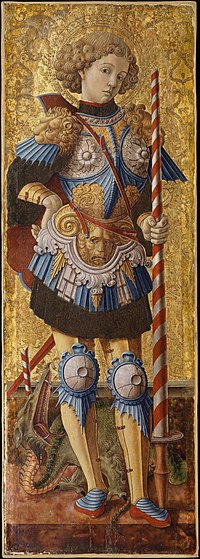
|
Saint George (died 23 April 303) was a soldier of Cappadocian Greek origin. A member of Roman emperor Diocletian's Praetorian Guard, he was sentenced to death for refusing to recant his Christian faith. He is immortalised in the legend of Saint George and the Dragon and his feast day is celebrated on 23 April. Saint George is claimed as their patron saint by England, Ethiopia, Georgia, Catalonia and several other nation states, as well as by various cities, universities, professions and organisations. This picture is a 97 cm × 34 cm (38 in × 13 in) painting of Saint George, depicted in armour with a dead dragon behind him, painted with tempera on a gold-ground wooden panel by Italian Renaissance artist Carlo Crivelli in 1472. Originally produced as part of a polyptych altarpiece for a Dominican church in the town of Ascoli Piceno, the panel is now in the collection of the Metropolitan Museum of Art in New York City. Painting credit: Carlo Crivelli
Recently featured:
|
April 24
Subpage 1
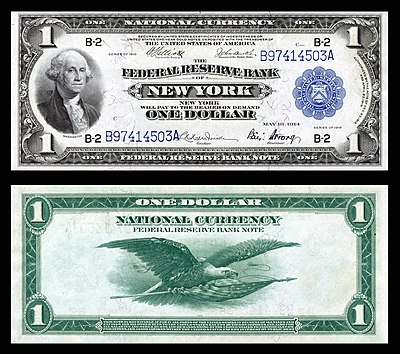
|
Federal Reserve Bank Notes were banknotes issued by the United States Federal Reserve between 1915 and 1934, differing from Federal Reserve Notes in that they were backed by one of the twelve Federal Reserve Banks, rather than by all of them collectively. They were first issued in 1915 in denominations of $5, $10 and $20, using a design that shared elements with both the National Bank Notes and the Federal Reserve Notes of the time. Additional denominations of $1, $2 and $50 were issued in 1918, a $100 note was designed but not issued, and a series of small-size notes was issued in 1933. This picture shows a one-dollar note issued in 1918 by the Federal Reserve Bank of New York, depicting President George Washington on the obverse, and an eagle with a flag on the reverse. This banknote is in the National Numismatic Collection of the Smithsonian Institution's National Museum of American History. Other denominations:Banknote design credit: Bureau of Engraving and Printing; photographed by Andrew Shiva
Recently featured:
|
Subpage 2

|
Federal Reserve Bank Notes were banknotes issued by the United States Federal Reserve between 1915 and 1934, differing from Federal Reserve Notes in that they were backed by one of the twelve Federal Reserve Banks, rather than by all of them collectively. They were first issued in 1915 in denominations of $5, $10 and $20, using a design that shared elements with both the National Bank Notes and the Federal Reserve Notes of the time. Additional denominations of $1, $2 and $50 were issued in 1918, a $100 note was designed but not issued, and a series of small-size notes was issued in 1933. This picture shows a two-dollar note issued in 1918 by the Federal Reserve Bank of Boston, depicting President Thomas Jefferson on the obverse, and a New York-class battleship on the reverse. This banknote is in the National Numismatic Collection of the Smithsonian Institution's National Museum of American History. Other denominations:Banknote design credit: Bureau of Engraving and Printing; photographed by Andrew Shiva
Recently featured:
|
Subpage 3
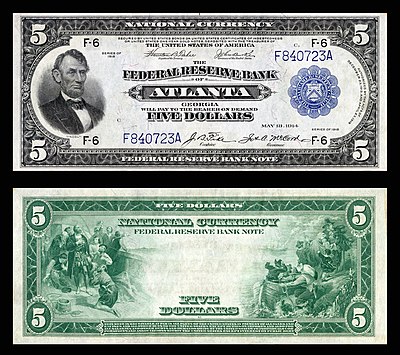
|
Federal Reserve Bank Notes were banknotes issued by the United States Federal Reserve between 1915 and 1934, differing from Federal Reserve Notes in that they were backed by one of the twelve Federal Reserve Banks, rather than by all of them collectively. They were first issued in 1915 in denominations of $5, $10 and $20, using a design that shared elements with both the National Bank Notes and the Federal Reserve Notes of the time. Additional denominations of $1, $2 and $50 were issued in 1918, a $100 note was designed but not issued, and a series of small-size notes was issued in 1933. This picture shows a five-dollar note issued in 1918 by the Federal Reserve Bank of Atlanta, depicting President Abraham Lincoln on the obverse, and vignettes of Christopher Columbus sighting land and the Pilgrims' landing on the reverse. This banknote is in the National Numismatic Collection of the Smithsonian Institution's National Museum of American History. Other denominations:Banknote design credit: Bureau of Engraving and Printing; photographed by Andrew Shiva
Recently featured:
|
Subpage 4
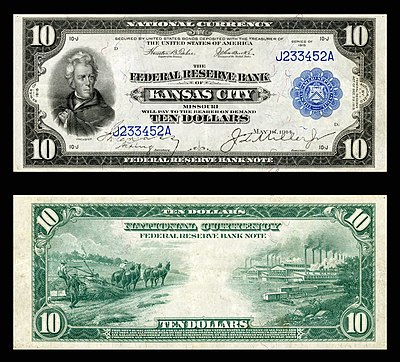
|
Federal Reserve Bank Notes were banknotes issued by the United States Federal Reserve between 1915 and 1934, differing from Federal Reserve Notes in that they were backed by one of the twelve Federal Reserve Banks, rather than by all of them collectively. They were first issued in 1915 in denominations of $5, $10 and $20, using a design that shared elements with both the National Bank Notes and the Federal Reserve Notes of the time. Additional denominations of $1, $2 and $50 were issued in 1918, a $100 note was designed but not issued, and a series of small-size notes was issued in 1933. This picture shows a ten-dollar note issued in 1915 by the Federal Reserve Bank of Kansas City, depicting President Andrew Jackson on the obverse, and vignettes of the agricultural and manufacturing industries on the reverse. This banknote is in the National Numismatic Collection of the Smithsonian Institution's National Museum of American History. Other denominations:Banknote design credit: Bureau of Engraving and Printing; photographed by Andrew Shiva
Recently featured:
|
Subpage 5

|
Federal Reserve Bank Notes were banknotes issued by the United States Federal Reserve between 1915 and 1934, differing from Federal Reserve Notes in that they were backed by one of the twelve Federal Reserve Banks, rather than by all of them collectively. They were first issued in 1915 in denominations of $5, $10 and $20, using a design that shared elements with both the National Bank Notes and the Federal Reserve Notes of the time. Additional denominations of $1, $2 and $50 were issued in 1918, a $100 note was designed but not issued, and a series of small-size notes was issued in 1933. This picture shows a twenty-dollar note issued in 1915 by the Federal Reserve Bank of Dallas, depicting President Grover Cleveland on the obverse, and vignettes of land, air and sea transportation on the reverse. This banknote is in the National Numismatic Collection of the Smithsonian Institution's National Museum of American History. Other denominations:Banknote design credit: Bureau of Engraving and Printing; photographed by Andrew Shiva
Recently featured:
|
Subpage 6

|
Federal Reserve Bank Notes were banknotes issued by the United States Federal Reserve between 1915 and 1934, differing from Federal Reserve Notes in that they were backed by one of the twelve Federal Reserve Banks, rather than by all of them collectively. They were first issued in 1915 in denominations of $5, $10 and $20, using a design that shared elements with both the National Bank Notes and the Federal Reserve Notes of the time. Additional denominations of $1, $2 and $50 were issued in 1918, a $100 note was designed but not issued, and a series of small-size notes was issued in 1933. This picture shows a fifty-dollar note issued in 1918 by the Federal Reserve Bank of St. Louis, depicting President Ulysses S. Grant on the obverse, and a personification of Panama between two ships on the Atlantic and Pacific Oceans on the reverse. This banknote is in the National Numismatic Collection of the Smithsonian Institution's National Museum of American History. Other denominations:Banknote design credit: Bureau of Engraving and Printing; photographed by Andrew Shiva
Recently featured:
|
Subpage 7

|
Federal Reserve Bank Notes were banknotes issued by the United States Federal Reserve between 1915 and 1934, differing from Federal Reserve Notes in that they were backed by one of the twelve Federal Reserve Banks, rather than by all of them collectively. They were first issued in 1915 in denominations of $5, $10 and $20, using a design that shared elements with both the National Bank Notes and the Federal Reserve Notes of the time. Additional denominations of $1, $2 and $50 were issued in 1918, a $100 note was designed but not issued, and a series of small-size notes was issued in 1933. This picture shows a one-hundred-dollar note printed in 1915 by the Federal Reserve Bank of New York, depicting Benjamin Franklin on the obverse; as this note is an unissued proof, there is no design on the reverse. This banknote is in the National Numismatic Collection of the Smithsonian Institution's National Museum of American History. Other denominations:Banknote design credit: Bureau of Engraving and Printing; photographed by Andrew Shiva
Recently featured:
|
April 25

|
Tract housing evolved in the 1940s when the demand for cheap housing rocketed after World War II. Economies of scale meant that large numbers of identical homes could be built faster and more cheaply to fulfil the increased demand. Developers would purchase a dozen or more adjacent lots and conduct the building construction as an assembly-line process. This type of development is often criticised by city planners and architects because it overlooks the concept of community building, instead creating a homogeneous residential neighborhood with no local employment, commerce, services, or attractions. This aerial photograph shows tract housing in the suburbs of Markham, a city in Ontario, Canada. Photograph credit: Ian Duke; edited by Eric Gaba
Recently featured:
|
April 26

|
Nototropis falcatus is a species of amphipod crustacean found in the northeastern Atlantic Ocean and North Sea, where it lives on the seabed. Growing to a length of about 7 mm (0.3 in), the third pereiopod or thoracic leg is particularly stout, and has a curved propodus (penultimate joint) and a powerful dactylus (claw). It can swim using its abdominal legs and orienting itself on its side, and can also burrow in the soft substrate. The species probably feeds by grazing on plant material and consuming detritus. This picture shows an N. falcatus individual collected at a dredge disposal site off Zeebrugge, Belgium. Photograph credit: Hans Hillewaert
Recently featured:
|
April 27

|
Caroline Rémy de Guebhard (27 April 1855 – 24 April 1929) was a French anarchist, journalist, and feminist, best known under the pen name Séverine. She was associated with Jules Vallès and became involved in his socialist publication Cri du Peuple, taking control of the newspaper when his health deteriorated. She left in 1888 after a confrontation with Marxist journalist Jules Guesde, but continued to write for other publications, promoting women's emancipation and denouncing social injustices. This picture of Rémy is a carte de visite taken by French photographer Nadar sometime between 1889 and 1899. The photograph, entitled "Séverine, debout, un poing sur la hanche" ('Séverine, standing, a fist on her hip'), is in the collection of the Bibliothèque Marguerite Durand in Paris. Photograph credit: Nadar; restored by Adam Cuerden
Recently featured:
|
April 28

|
Old Age is the fourth in a series of allegorical oil-on-canvas paintings by American artist Thomas Cole, entitled The Voyage of Life, which represent man's journey through life. The final painting is an image of death. The man, still in his boat, has grown old, and the waters of the river have calmed as they flow into the sea of eternity. The figurehead and hourglass are missing from the battered boat; the withered old voyager has reached the end of earthly time. His guardian angel hovers close to the boat, while angels descend from heaven in the distance. The landscape is practically gone, with just a few rough rocks representing the edge of the earthly world, and dark water stretching ahead. This painting, along with the other three in the series, was painted in 1842 and is held by the National Gallery of Art in Washington, D.C. Painting credit: Thomas Cole
Recently featured:
|
April 29

|
|
The Neo Geo CD is the second home video game console of SNK's Neo Geo family, released in 1994, four years after its cartridge-based equivalent. The unit's 1X CD-ROM drive was slow, with very long loading times, and the system could also play audio CDs. The Neo Geo CD was launched bundled with a control pad, instead of a joystick like the previous AES version. However, the original AES joystick can be used with all three Neo Geo CD models. The picture shows the top-loader model of the Neo Geo CD system, with a plugged-in controller consisting of an analog stick, four colored buttons, and two buttons labelled "select" and "start". The CD-ROM drive and the power button are visible at the top of the console, with two controller ports at the front. Photograph credit: Evan Amos
Recently featured:
|
April 30

|
The presidency of George Washington began on April 30, 1789, when he took office after the 1788–89 election, the United States' first quadrennial presidential election. He was unanimously re-elected in the 1792 presidential election. Having chosen to retire after two terms, he was succeeded by his vice president, John Adams of the Federalist Party, in 1797. This picture is a line engraving of Washington, produced around 1902 by the Department of the Treasury's Bureau of Engraving and Printing (BEP) as part of a BEP presentation album of the first 26 presidents, which was reportedly given to Treasury Secretary Lyman J. Gage. Similar portraits of Washington have been used on designs for the $1 bill. Engraving credit: Bureau of Engraving and Printing; restored by Andrew Shiva
Recently featured:
|
Picture of the day archives and future dates
